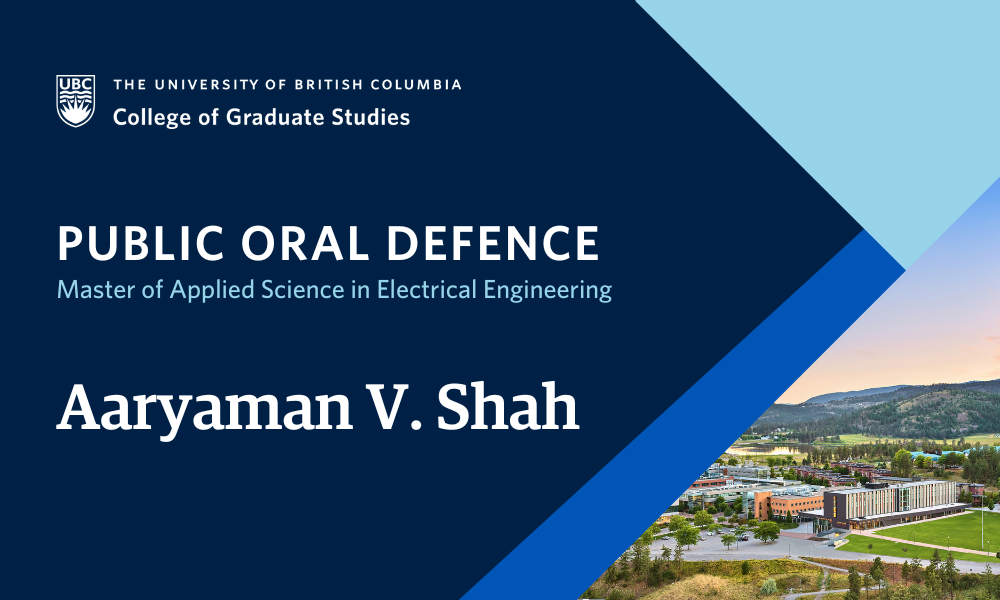
- This event has passed.
Thesis Defence: Towards Integrated Microwave Ice Sensors for On-ground, In-flight and Unmanned Aerial Vehicle (UAV) Applications
February 5 at 1:00 pm - 5:00 pm

Aaryaman V. Shah, supervised by Mohammad H. Zarifi, will defend their thesis titled “Towards Integrated Microwave Ice Sensors for On-ground, In-flight and Unmanned Aerial Vehicle (UAV) Applications” in partial fulfillment of the requirements for the degree of Master of Applied Science in Electrical Engineering.
An abstract for Aaryaman V. Shah’s thesis is included below.
Defences are open to all members of the campus community as well as the general public. Please email mohammad.zarifi@ubc.ca to receive the Zoom link for this defence.
ABSTRACT
Ice accretion on aviation surfaces imposes operational and safety challenges, severely impacting critical flight structures and equipment. For optimized ‘smart’ de-icing systems of the future, microwave resonant-based planar sensors are proposed for their high sensitivity to icing and versatility in integration. This thesis presents five microwave resonant sensors for ice sensing under real-world simulated icing conditions.
Three planar ice sensors are designed for harsh roadway or runway environments. A Split-Ring Resonator (SRR) sensor (1.2 GHz) is tested for sensitivity to icing with protective epoxy coatings. A complementary split ring resonator (CSRR) sensor with a robust epoxy-coated 1mm-thick aluminum build (1.18 GHz) monitors snow accretion. Asymmetric stripline CSRR sensors with increased shielding are implemented for exploratory time-domain-reflectometry (TDR) measurements, for wired large-area sensor networks.
A conformal single-port dual-frequency SRR sensor (1.9-2.2 GHz) was integrated onto a NACA 0018 airfoil with electrothermal de-icing capabilities to sense in-flight ice crystal icing (ICI). Tested in the National Research Council’s (NRC’s) Research Altitude Test Facility (RATFac) at 19,000 ft, 100 m/s, +3°C and melt ratios of 11%, 13%, 16% and 25%, the sensor differentiates %melt while monitoring de-icing and anti-icing processes.
Icing on smaller unmanned aerial vehicles (UAVs), drones, and electric vertical take-off and landing (eVTOL) crafts impact aerodynamics and weight, severely limiting operation. A novel multi-frequency SRR sensor (2-4 GHz) is integrated with a zone-based electrothermal de-icing system and a low interfacial-toughness coating on a NACA 0012 airfoil for location-specific accretion monitoring and zone-based ‘smart’ de-icing. Tested at the Anti-Icing Materials International Laboratory’s (AMIL) icing wind tunnel at varying LWC (0.3, 0.5 and 0.8 g/m3), airspeed (20 and 40 m/s) and temperature (-5°C: glaze, -10°C: mixed, and -20°C: rime) conditions, the sensor monitors ice accretion, tracking the real-time resonant frequency response with a maximum sensitivity of 179 MHz/mm. A fitted time-constant is found to be inversely proportional to increasing ice thickness, facilitating icing rate measurement and ice thickness prediction using real-time microwave sensors.
This work represents a significant advancement in the field of microwave SRR ice sensing technology, bringing it one step closer to practical implementation as integrated location-specific ice sensors for ‘smart’ ice protection systems (IPSs).